Ecuador and the Galapagos – Day 4 can be found here.
The knock came at 5:30 am, as expected. I’d slept fairly well that night, but I was still more than grateful for the strong Ecuadorian coffee in my cup that morning.
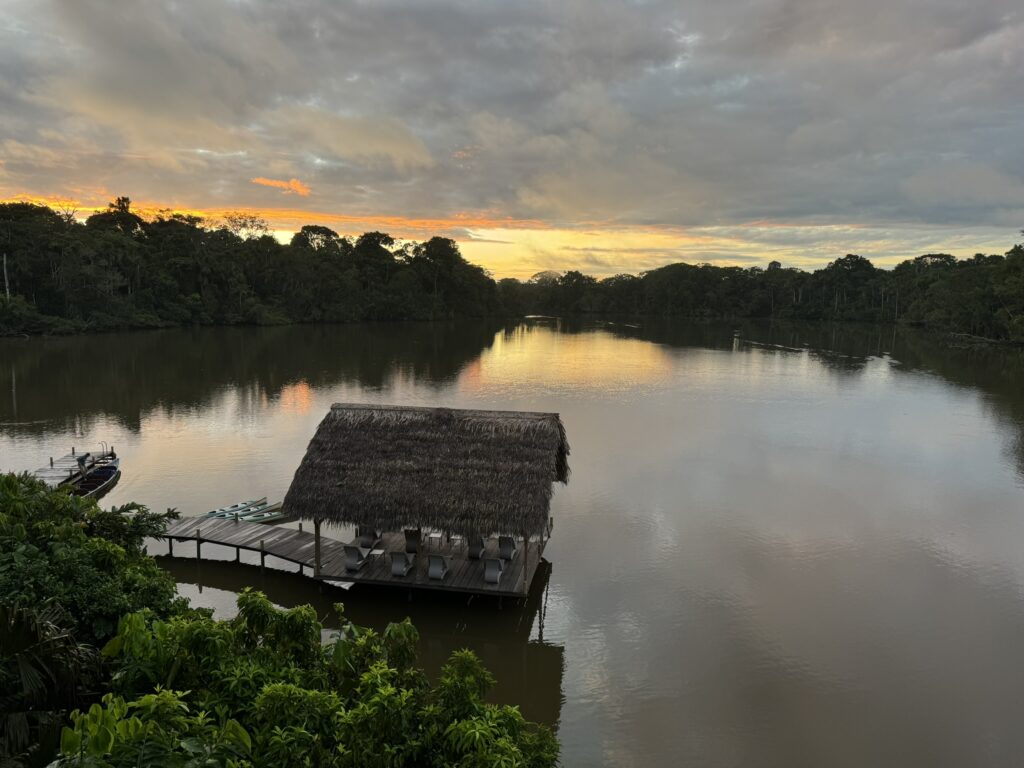
I’d need the energy – today’s plan was to visit both a parrot “clay lick” and one of the local villages. To do so, we’d need to canoe back up to the dock, at which point we’d hike the brief stretch back to the Napo river and re-board the motorized canoe that would take us to both the clay lick and the village.
Simple, right?
Generally, we are not huge fans of village tours. We have deep respect for the inhabitants of this region, we’re just concerned that these kinds of visits can be cheap and exploitive. But La Selva’s excursions have been excellent thus far, so we’re willing to give them the benefit of the doubt that this too will be well-run.
Well, we’ll find out soon enough.
Breakfast this morning was slightly different – there were pancakes now, as well as the usual sausage and omelettes. I opted for pancakes, sausage, scrambled eggs, pineapple and the much-needed coffee (sadly not photographed).
Guests are expected to be depart on their excursions one hour after wake-up, and today was no exception. And we were uniformly ready to go at 6:30 am, delayed only by another troupe of titi monkeys crossing through the resort grounds.
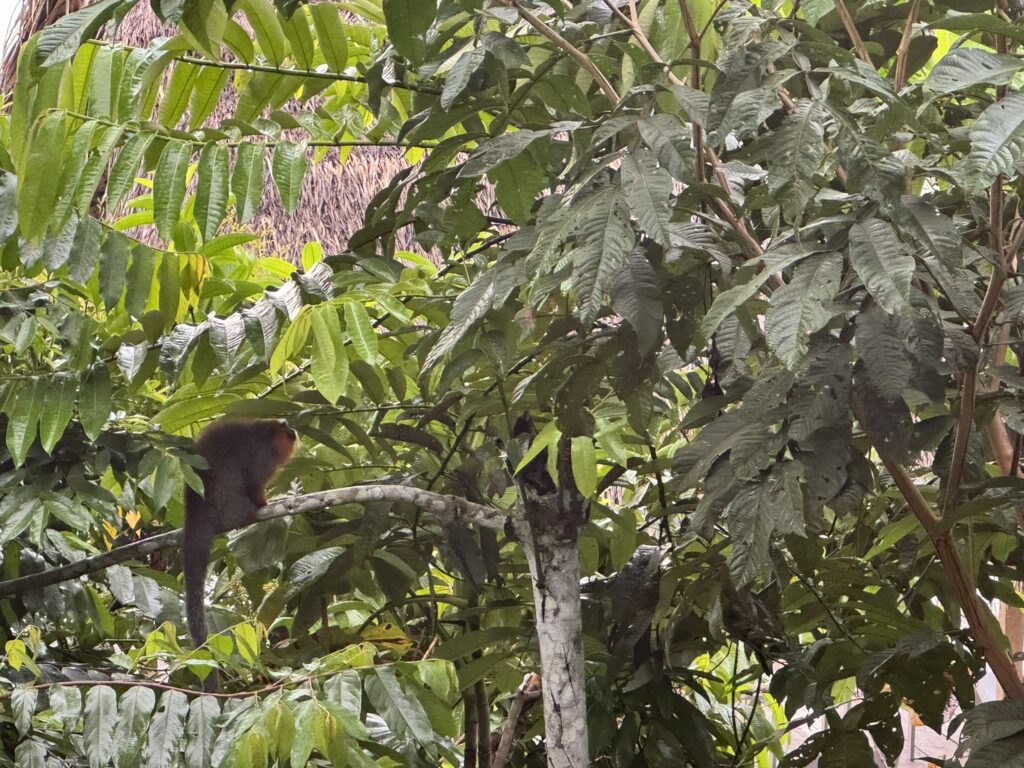
But apart from this brief delay, we were off and away at the expected time.
Most excursions at La Selva are done in small groups of 4 to 8 people. Our own group is 6 people – the 4 of us, plus 2 others. We would be joined today by another group of around 6 people. We would each be transported in hand-paddled canoes from the lodge, and then share the motorized canoe to both the clay lick and the village.
The non-motorized trip up the lagoon and the small river was again beautiful, peaceful, and serene. Leaving as early as we did, we saw some wildlife along the way:
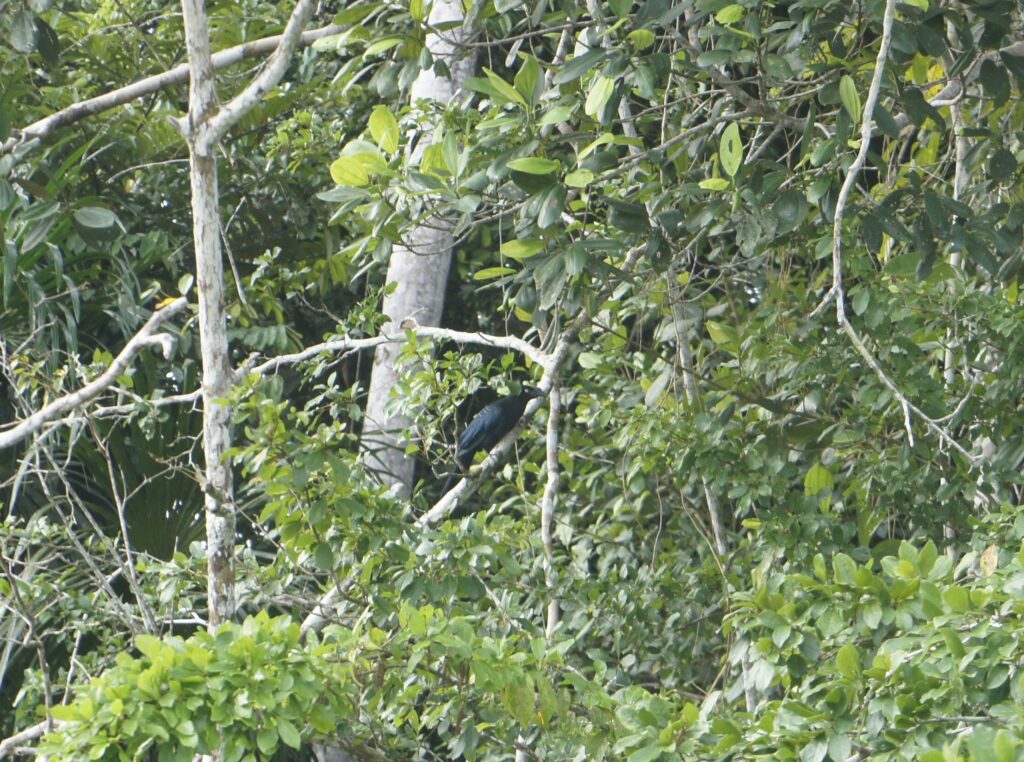
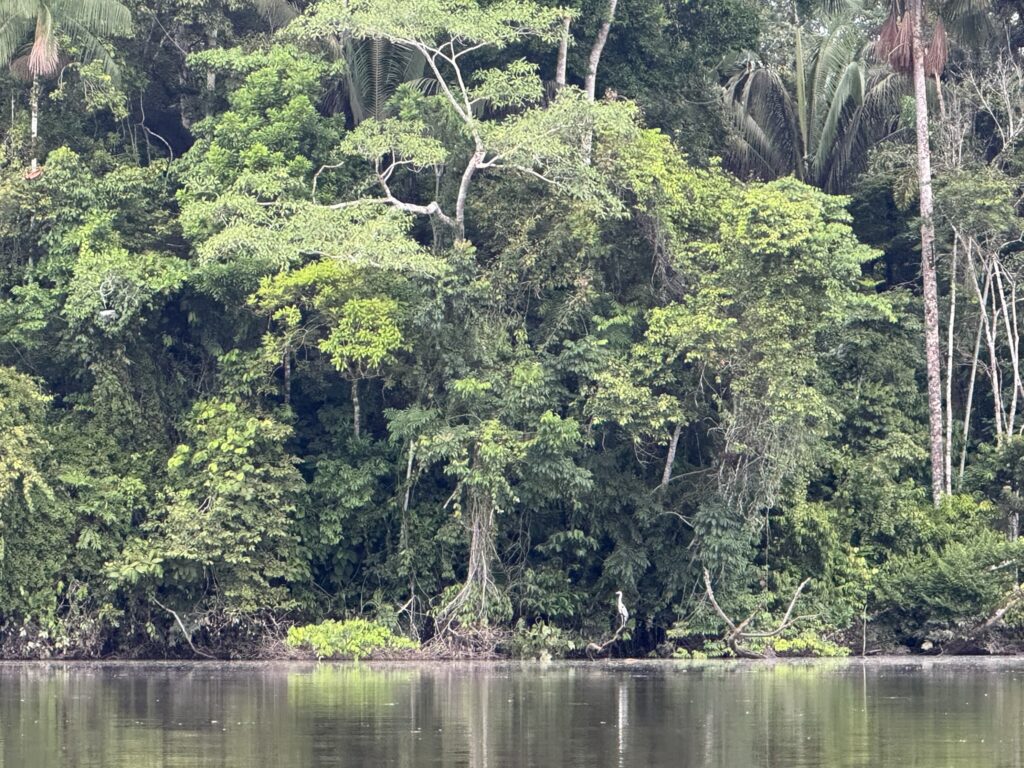
It wasn’t long before we reached the dock, and we re-boarded the motorized canoe. Has it only been two days since we were upon it last? It seems like a lifetime ago – harking back to a distant point in time when we hadn’t seen titi monkeys or boas in the wild.
It was only a five minute boat ride to the clay lick, though sadly the parrots and macaws were giving it a wide berth that morning. The working theory was that there was some sort of predator nearby, waiting for the birds to land. A snake or a boar, perhaps? Unlikely that it would be a jaguar – not only due to their rarity, but also due to their nocturnal nature.
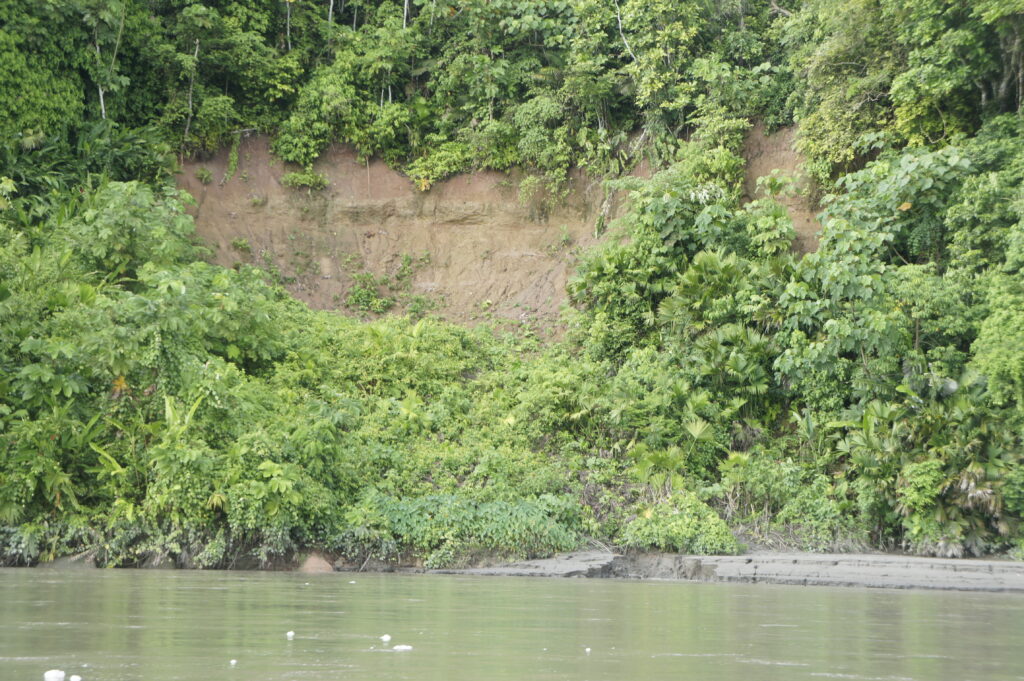
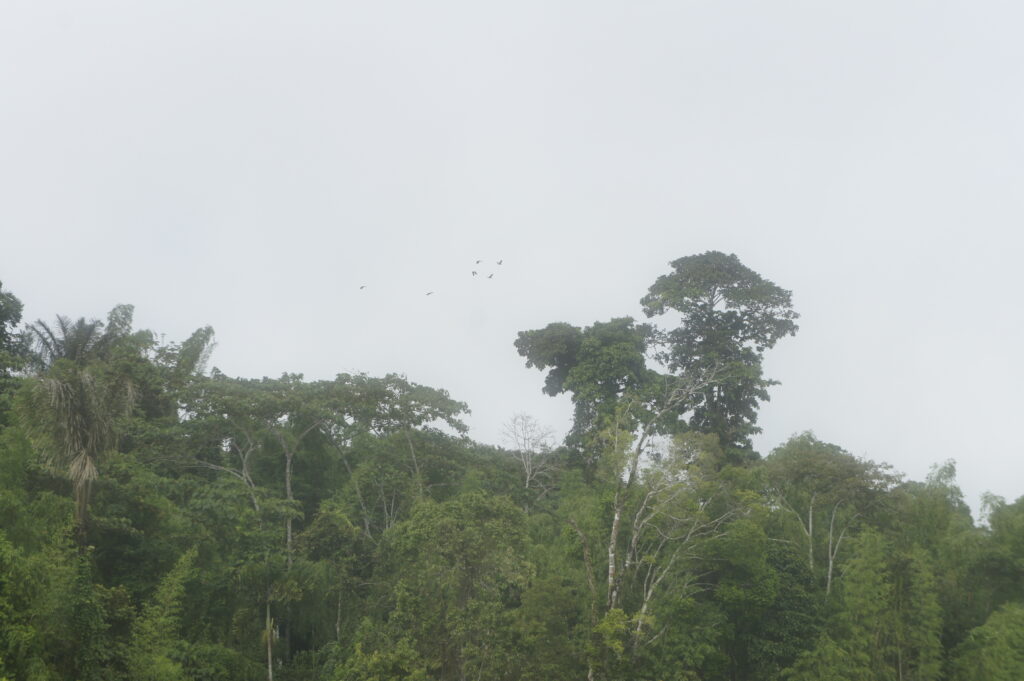
Still, we did see some parrots and other birds about – and we’ve seen our fair share of scarlet macaws in Costa Rica – so it’s hard to complain.
We did make another stop a bit further up the river, where we spotted some howler monkeys high up in a tree:
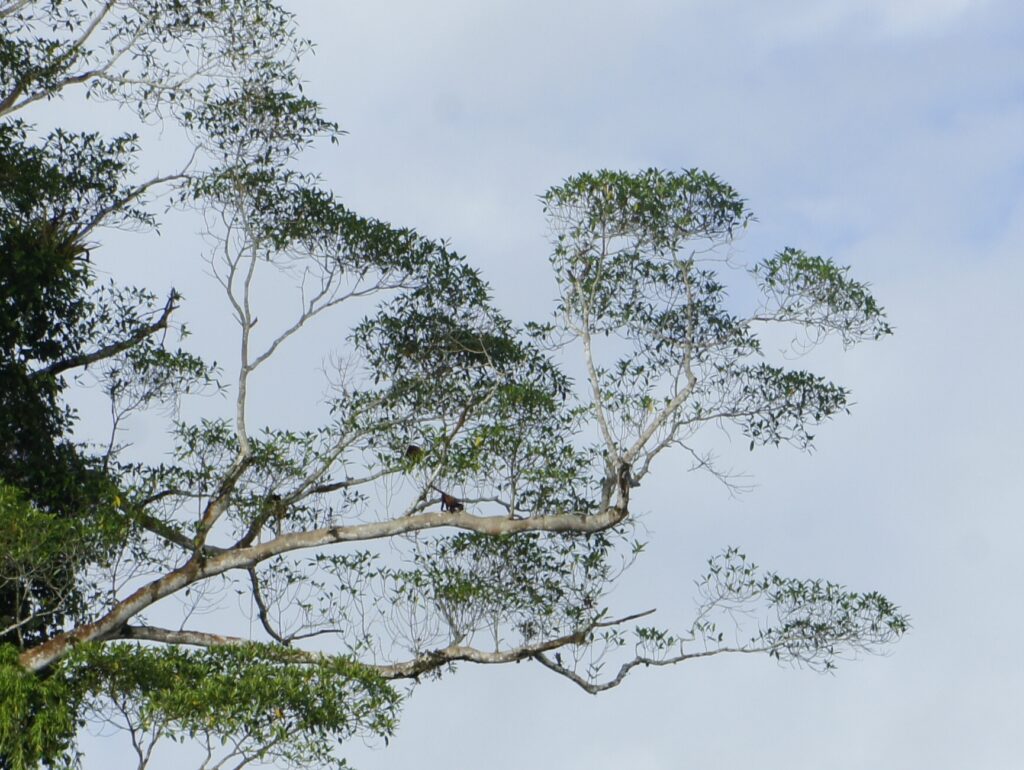
So that was an unexpected benefit.
Then we were off to the village of Pilche, which was about 10 minutes further upriver.
This particular community spans around 8,000 hectares along the river in both directions. The village serves as a common gathering point where children can go to school, they can discuss the management of the village, and where they can play soccer. (Not necessarily listed in order of importance.)
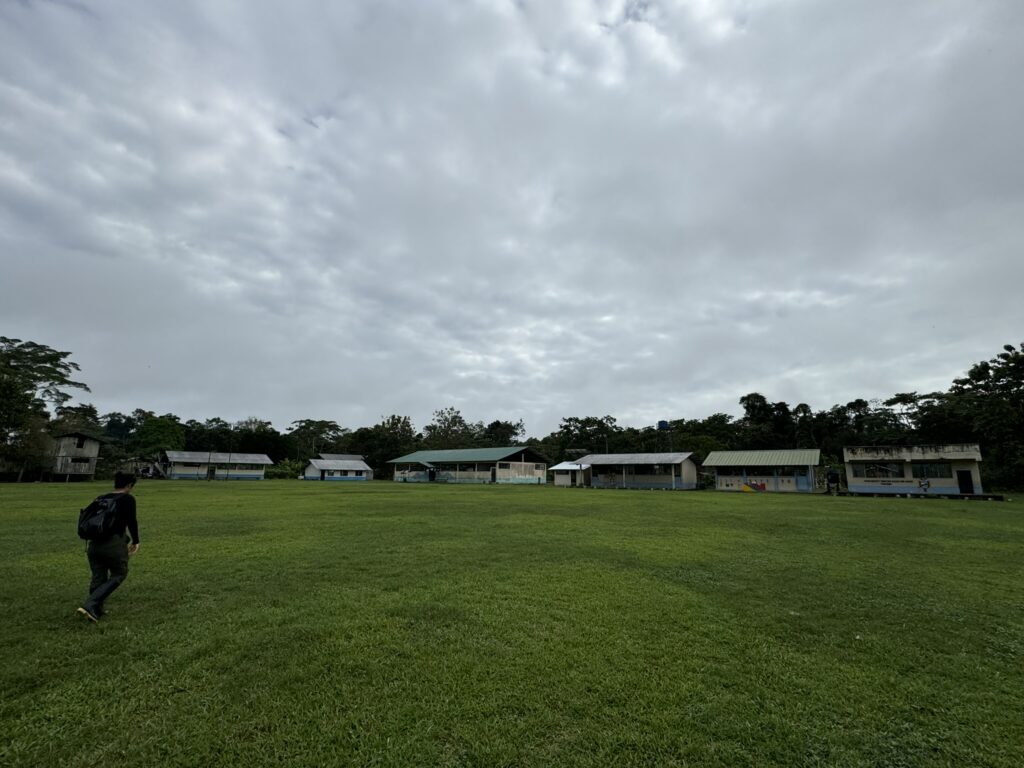
The schools are funded by the Ecuadorian government, though there was a period of time in which they would only send student teachers at the end of their practicums. This was less than idea for a whole range of reasons, most notably the fact that teachers would often leave before the end of the school year. But several members of the nearby villages have since qualified as teachers, dramatically improving the quality and consistency of education.
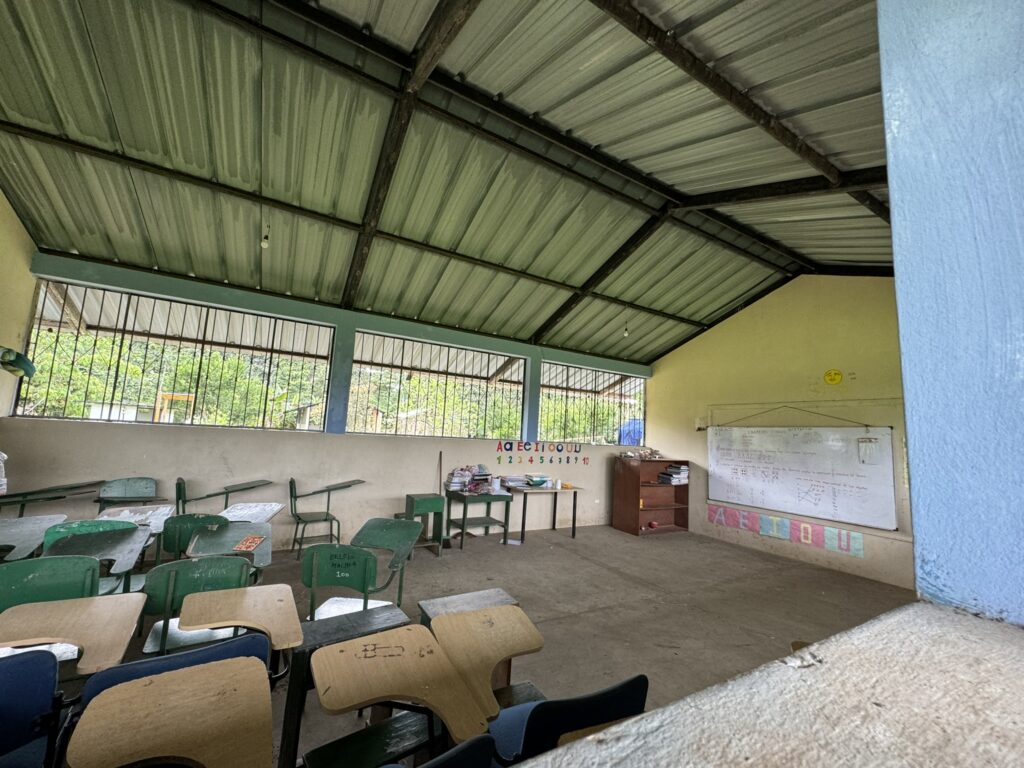
While it was clear that this was not a lavishly wealthy community, we were impressed by the way that the tour was run – it was clear that its intent was more to educate than to entertain.
Sandra first showed us around the communal buildings, and then took us through a model farm similar to what one might find at any of the houses in their community. There was a mixture of plants there that had a range of uses – some food, some medicine, and others used for crafting.
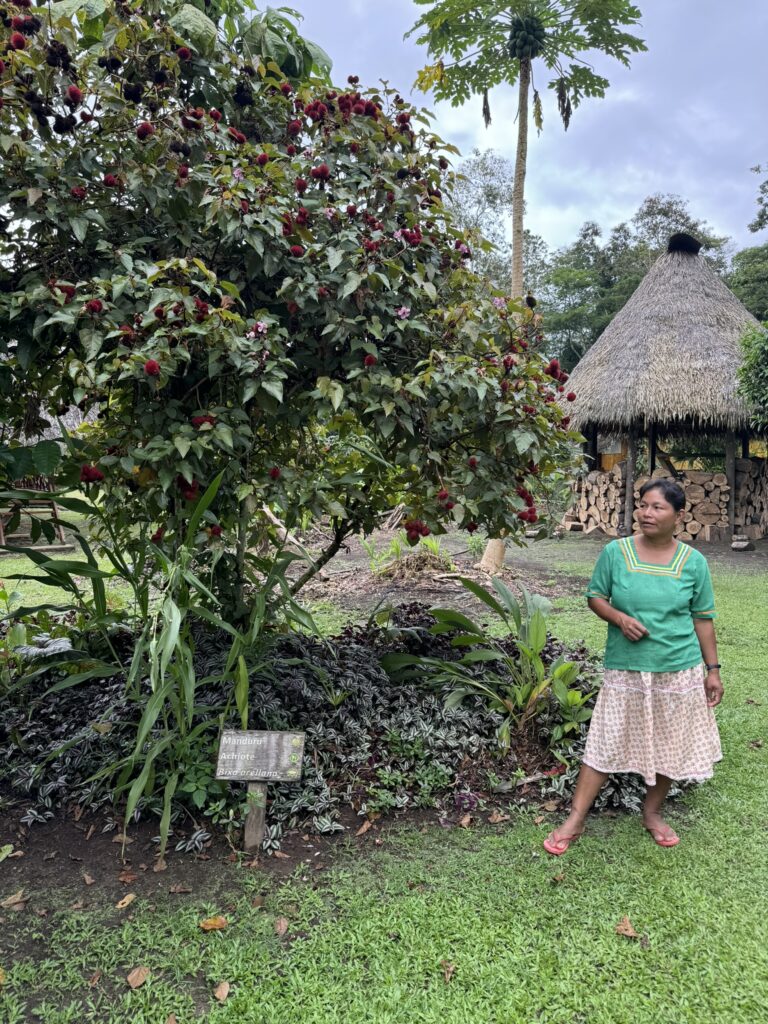
The dye from the manduru tree is still used in the community, particularly for weddings and other ceremonies – and occasionally for soccer.
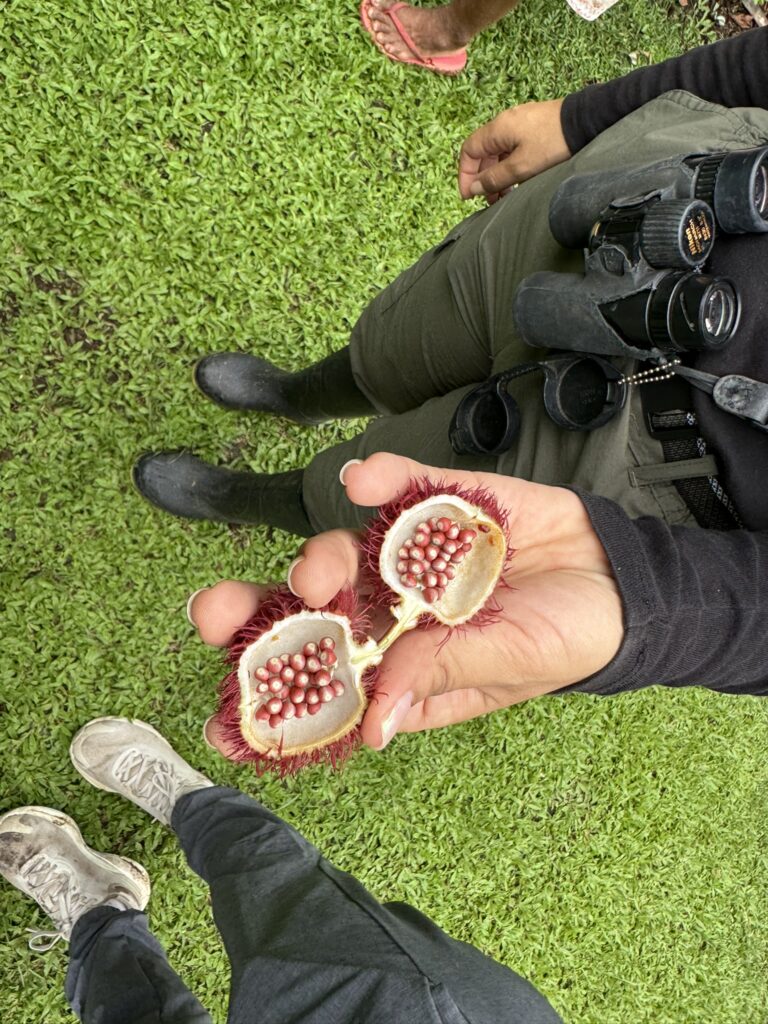
The uncontacted tribe is adjacent to this village. Our guide told us that the schism between the communities dates back to the 1940s. Sandra, the village representative, told us that even when she was a child, she had been told to run if she ever saw someone who had their feet painted with this red dye, as it was one of the identifying traits of the warriors of the uncontacted community. Child abductions by the uncontacted tribe (presumed to be to increase and broaden the population) occured up until a decade ago but with stepped-up patrols it hasn’t been an issue for many years.
After, we went inside a model home where they were brewing some tea and cooking some of their typical food for us to enjoy – including palm beetle larvae, which is quite the delicacy, and tilapia steamed inside ‘stoneleaf’.
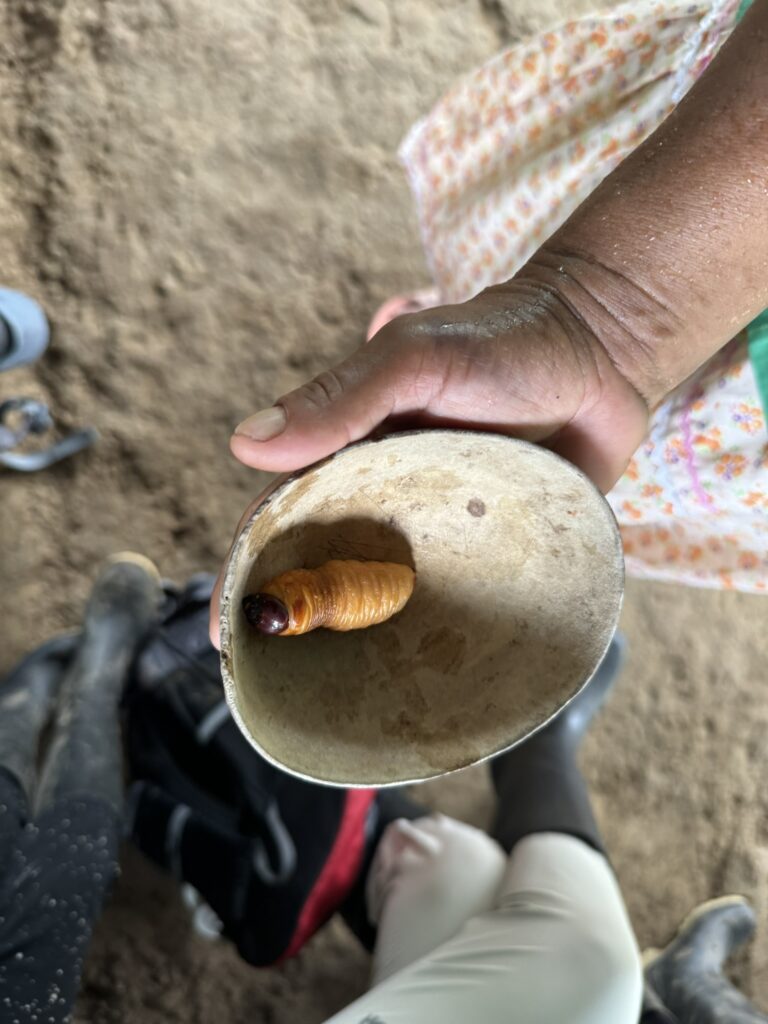
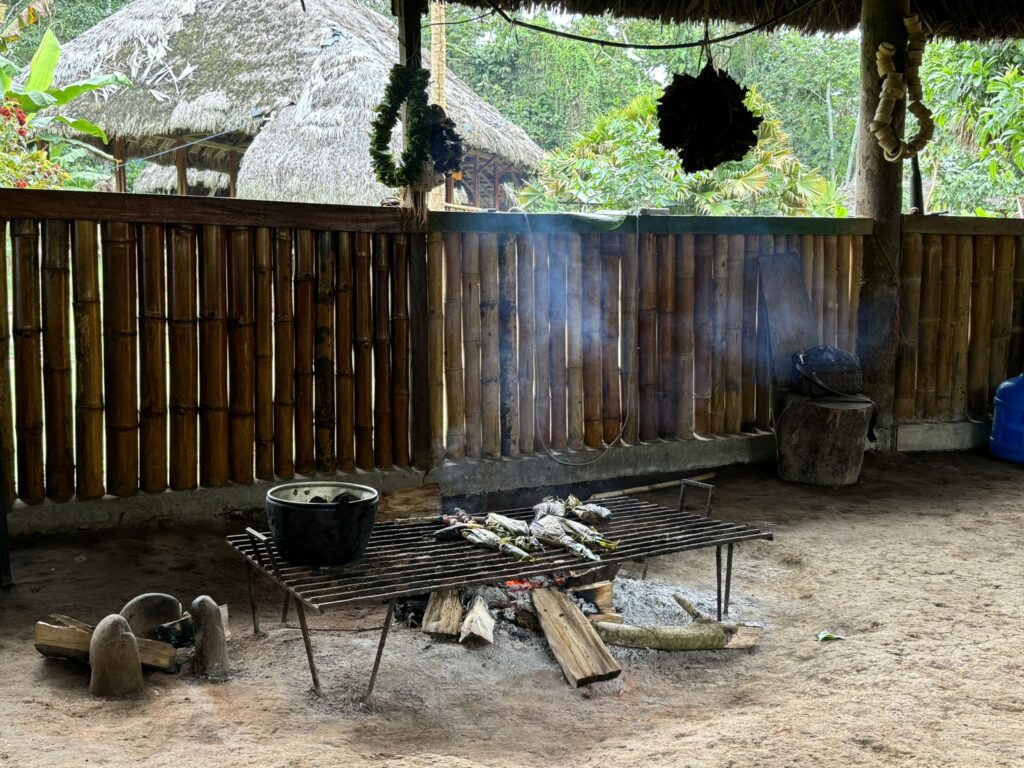
Beetle larvae roasting on an open fire… (see back-left corner of the grill)
I did have some of the larvae – it had a rich and distinctive taste, but I preferred the fish.
The village is also host to a range of projects from organizations like USAID and the World Wildlife Foundation – one of which included the opportunity to ‘adopt’ turtle hatchlings to help them be introduced to the wild.
The local tea, Wayusa – a relative of yerba mate – is a staple of the morning routine, and is brewed dark and strong. We were only given a much milder blend that wouldn’t hurt our tender stomachs. Consumed daily in large quantities, it helps to keep away mosquitoes.
We were also shown how to make chicha – a fermented beverage including yuca, sweet potatoes and plantains. It’s considered common hospitality to offer anyone who passes a cup of chicha.
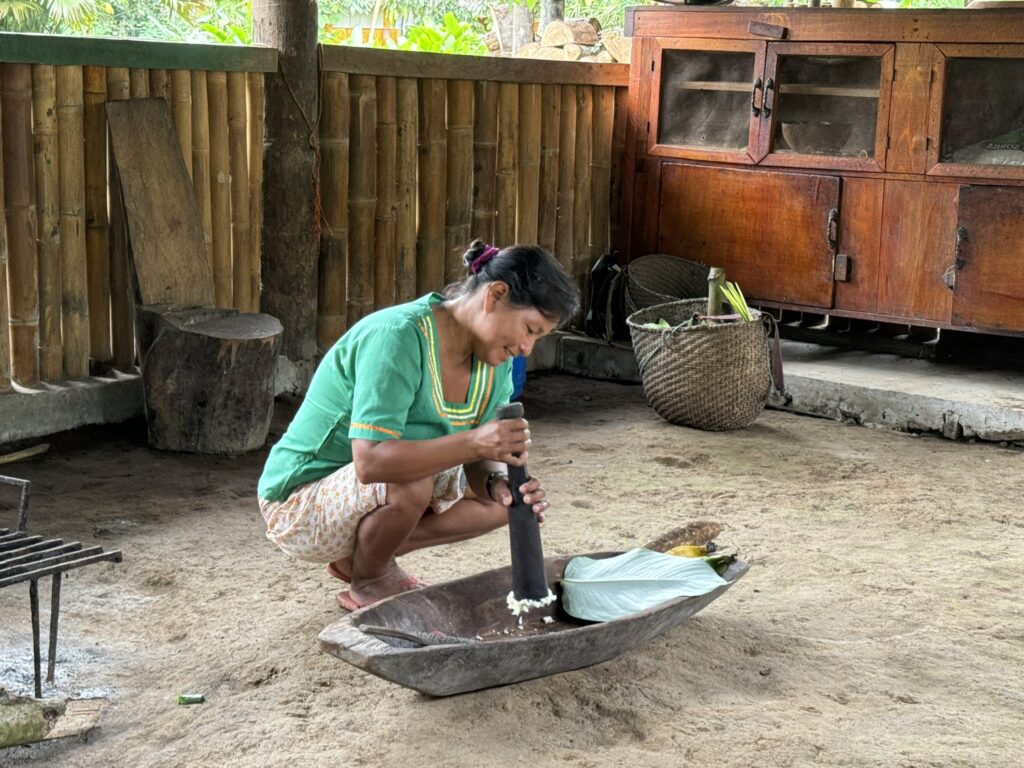
Sandra accidentally managed to give herself a black eye by wielding the masher with just one hand. She joked that it was the masher’s way of reminding her that she needed to do it properly.
(This is a scaled-down version of the actual trough for making chicha, which is generally four times this size.)
The paste itself is fermented, rather than the entire beverage – the drink itself is then reconstituted by adding water at the very end. Even without water, the paste can be eaten if needed. It’s a nutritious and filling dish that can fill in the gaps when it’s not possible to fish.
The Pilche home – made of local trees, reeds, and bamboo – can last for upwards of 30 years if built properly. The fire is moved throughout the house so as to help season and waterproof the roof, and to keep away animals. Generally the house itself is open to the air, though low bamboo walls help keep the animals out.
We then had the chance to browse some of the local handicrafts – we bought a couple of beaded hummingbirds and adopted two of the turtles (Leonardo and Warrior).
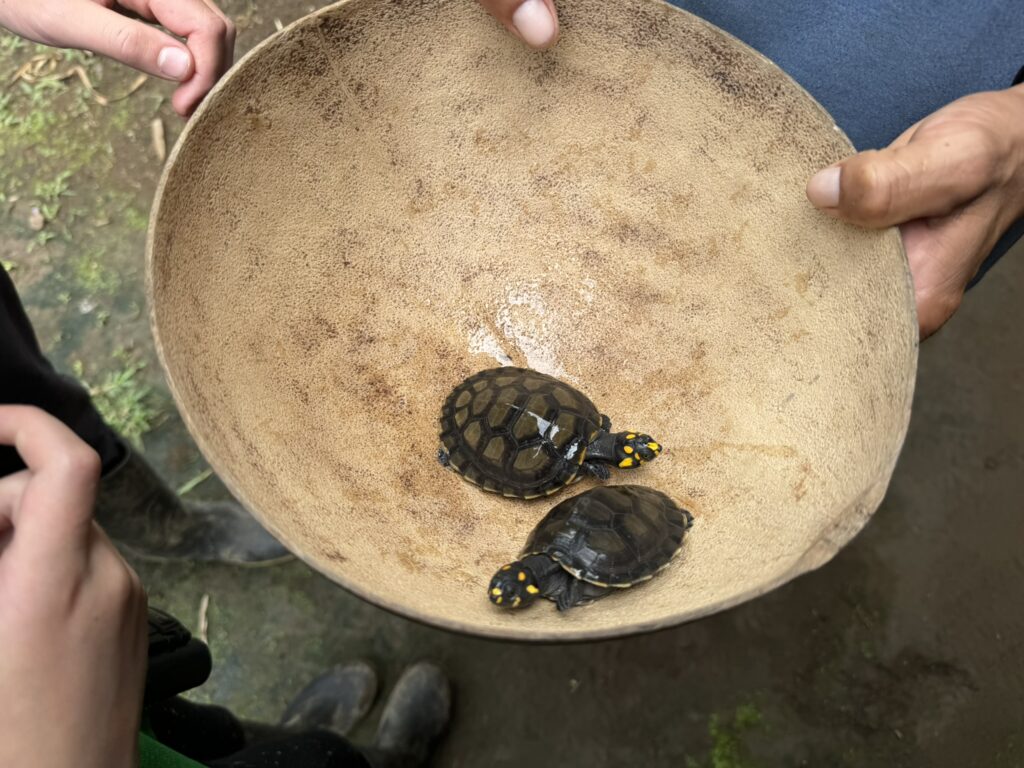
Though initially reluctant to take the tour, we ended up quite enjoying it and felt that it was done in a respectful and educational fashion. It wasn’t strenuous, and we appreciated having access to bathroom facilities on site.
We then re-boarded the motorized canoe, once more driving-past the still-empty claylick on our way back to the docks and the small river that led to the lagoon and La Selva.
It was here that the adopted turtles were introduced to the wild:
Unlike ocean turtles with very specific homing instincts, these ones are meant to live in lagoons and have a very very low survival rate if released in the Napo river so we were asked to release them in a protected lagoon to slightly increase their odds.
Afterward, there was an honour guard of turtles to welcome us back to the lagoon:
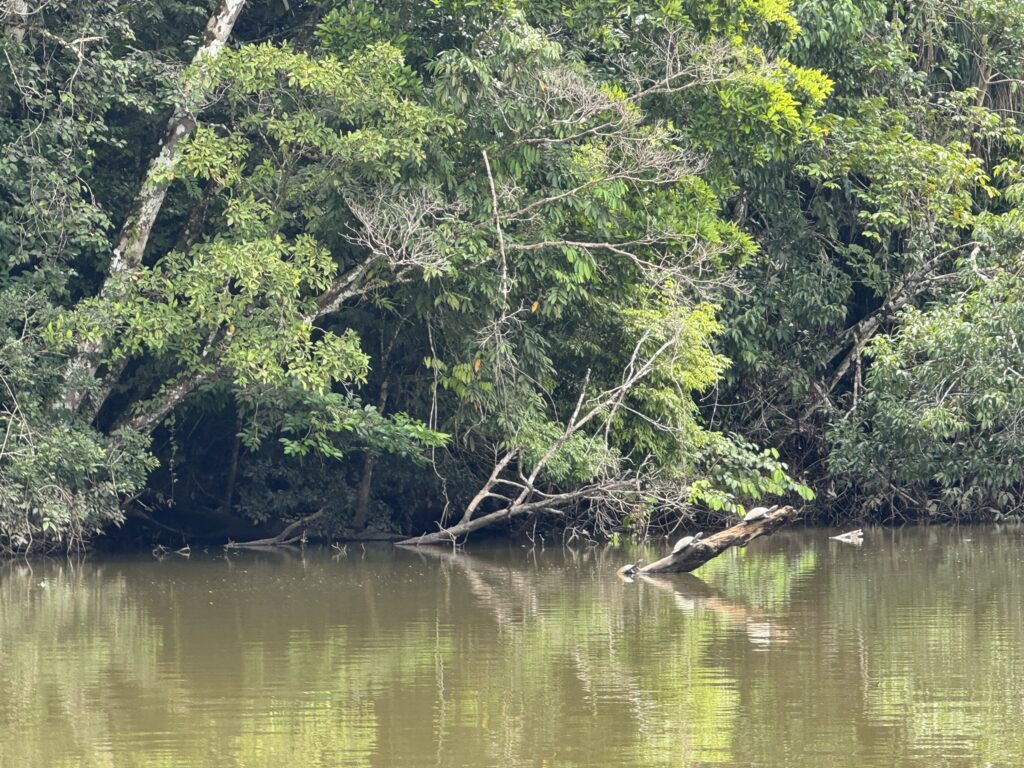
We ended up getting back to the resort before 11:30 am, which gave us some time to read and relax before a delicious lunch of baked pork, crispy corn, and assorted other starches – palm hearts and sweet potato, perhaps?
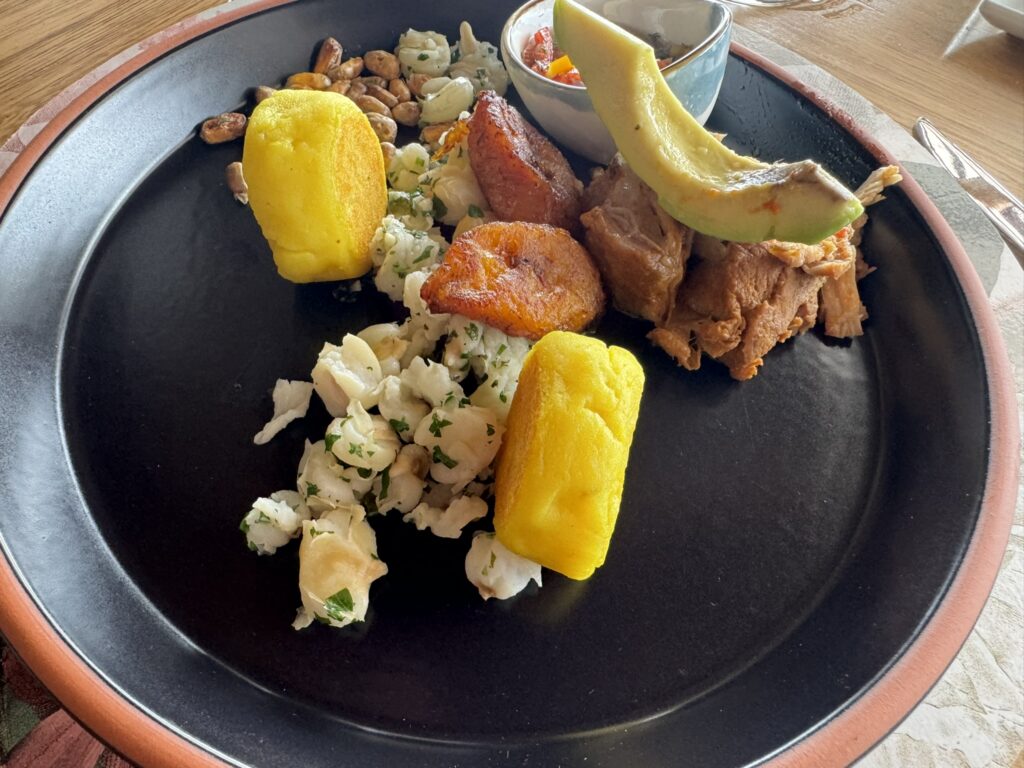
The kids went off to fish for piranhas, while I immediately crashed out for a much-needed nap.
And when I returned – victory! – our daughter had caught a red-bellied piranha, while my wife caught a yellow-bellied piranha.
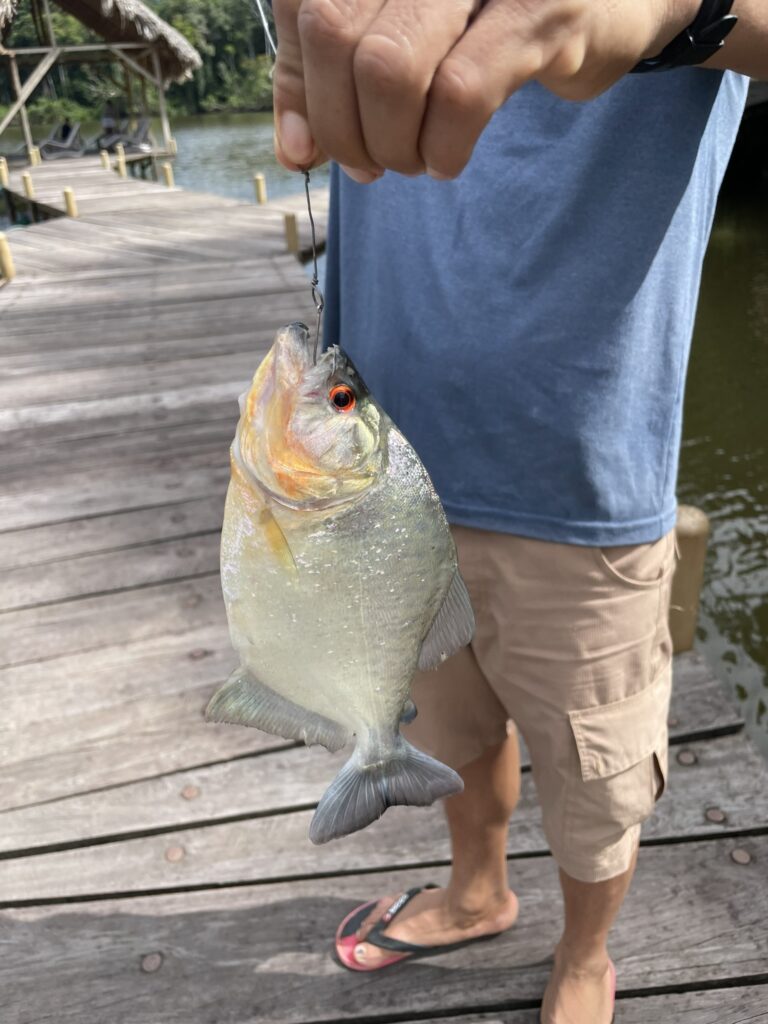
But it wasn’t long before we had to get ready for our evening excursions – a brief walk along a new trail, followed by a canoe ride into some of the further reaches of the lagoon.
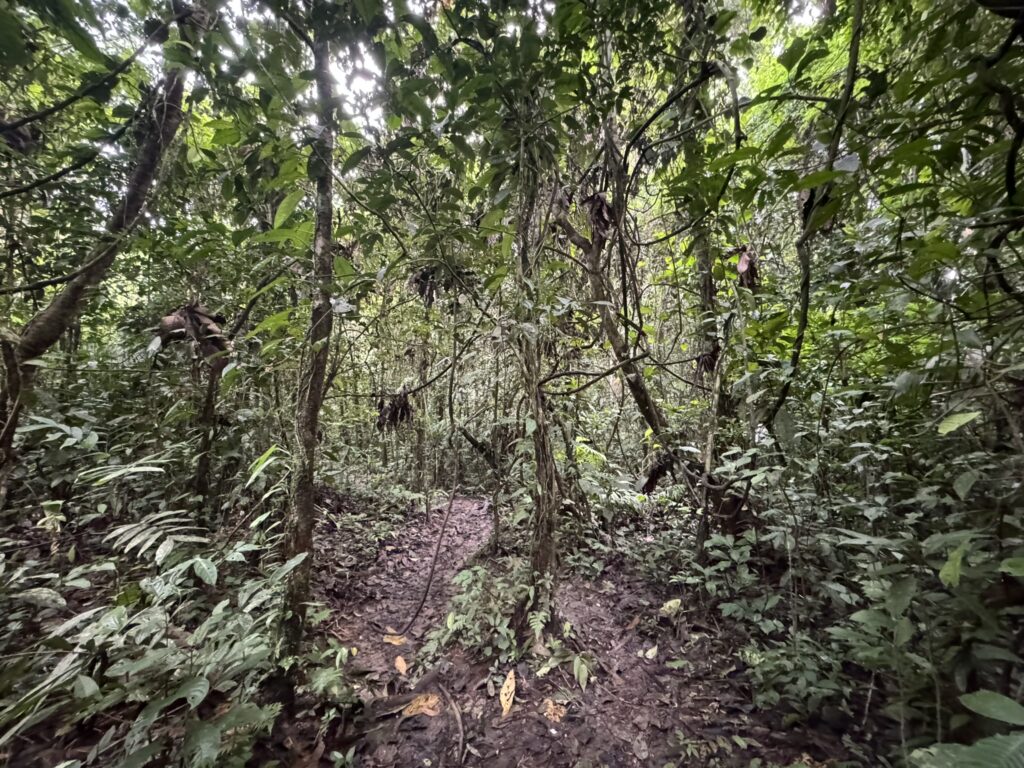
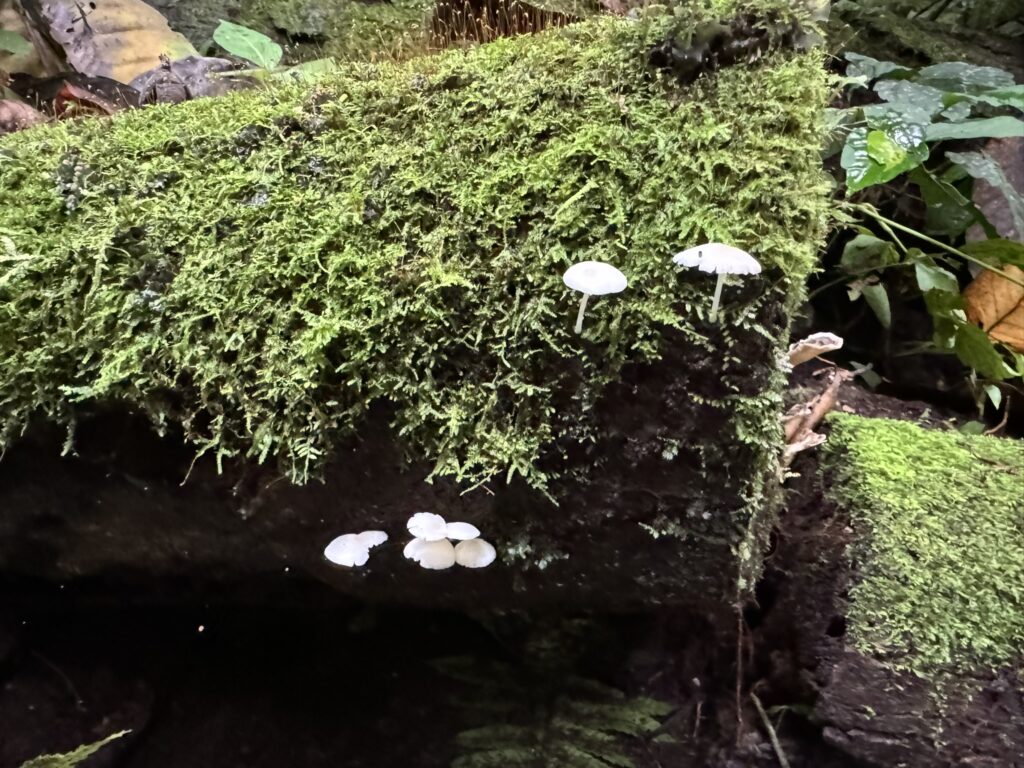
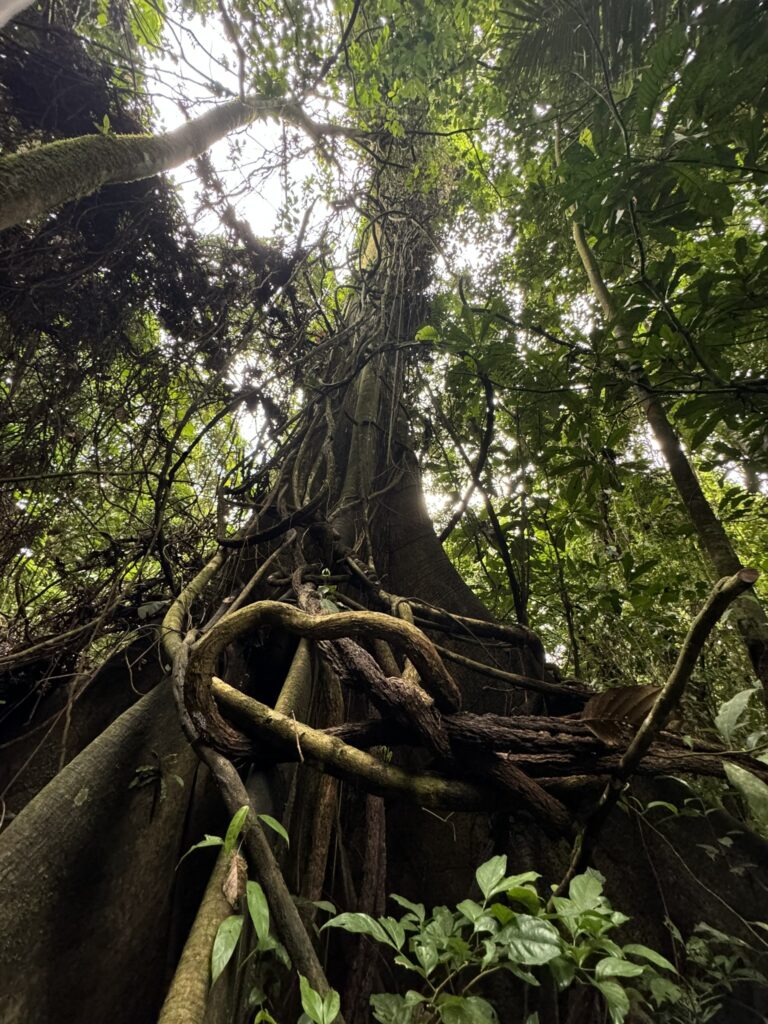
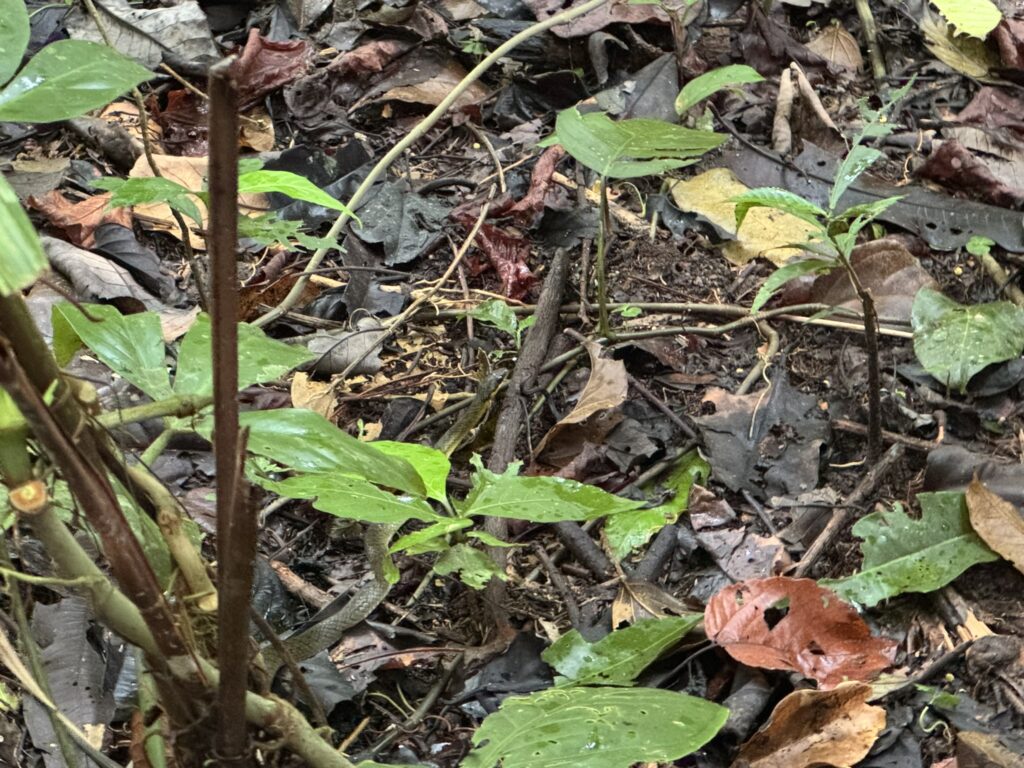
Snake #3!
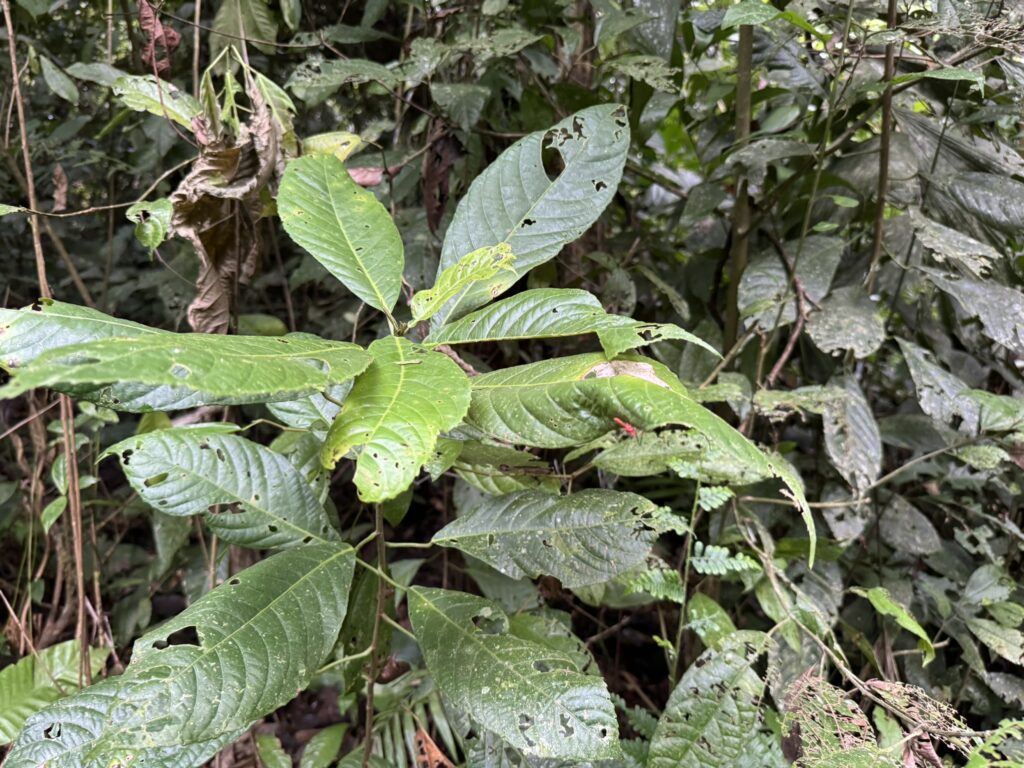
… And a stinkbug
It was during the walk that we saw the yanchama tree, which our local guide Henry said was used by his community as a means of making cloth. They would strip off a section of the bark at a time – without killing the tree – and treat it so that it could be used to make a range of different types of clothing. His community has long since switched to modern fabrics, but he remember this as a key fact that was passed on by his elders.
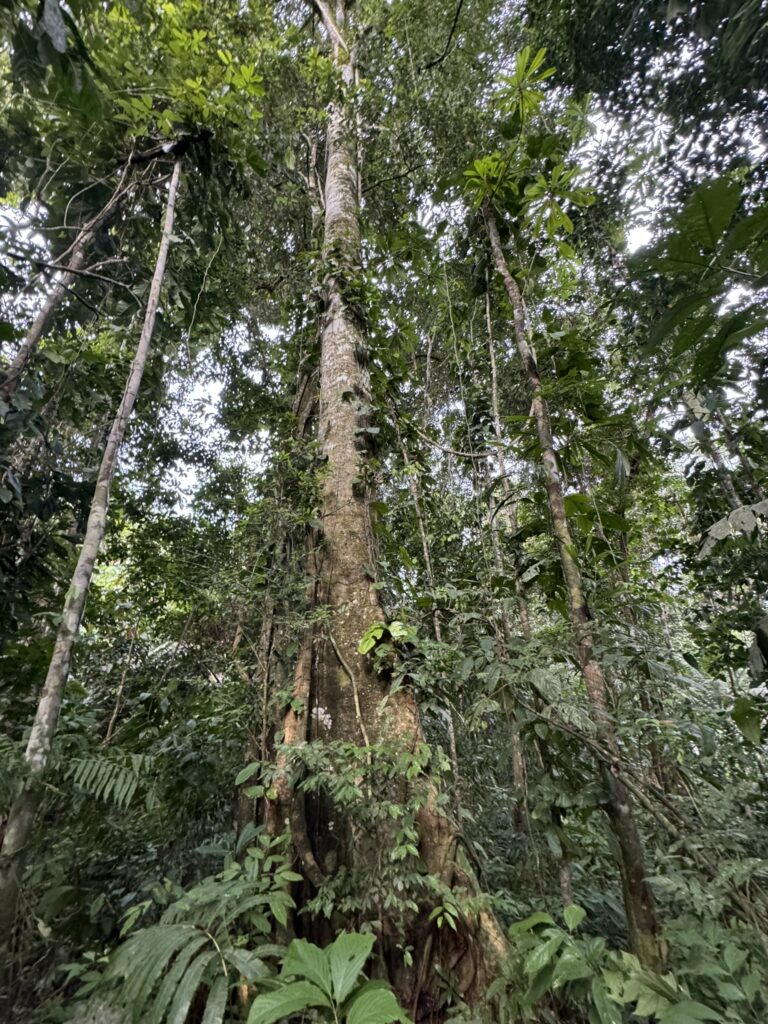
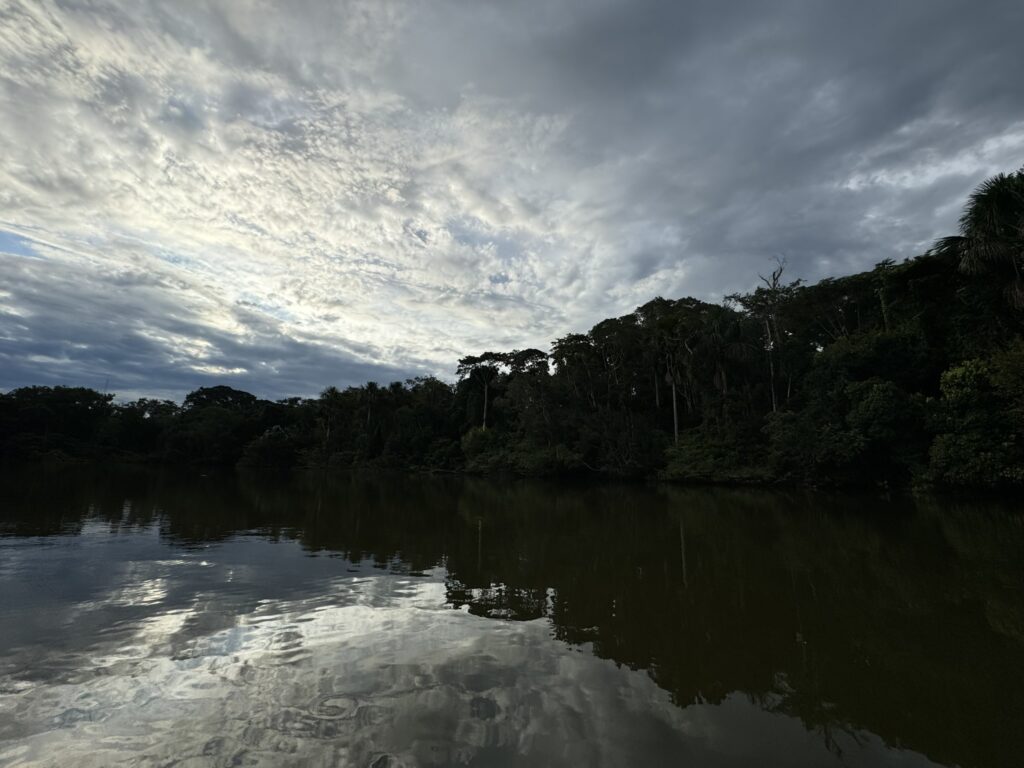
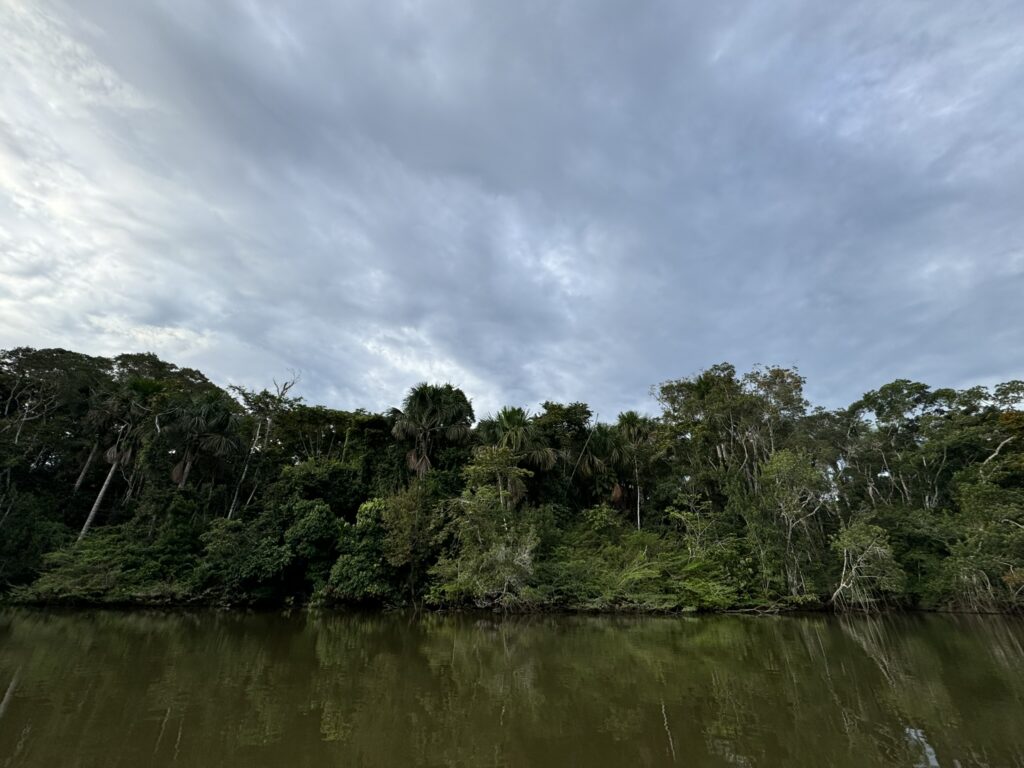
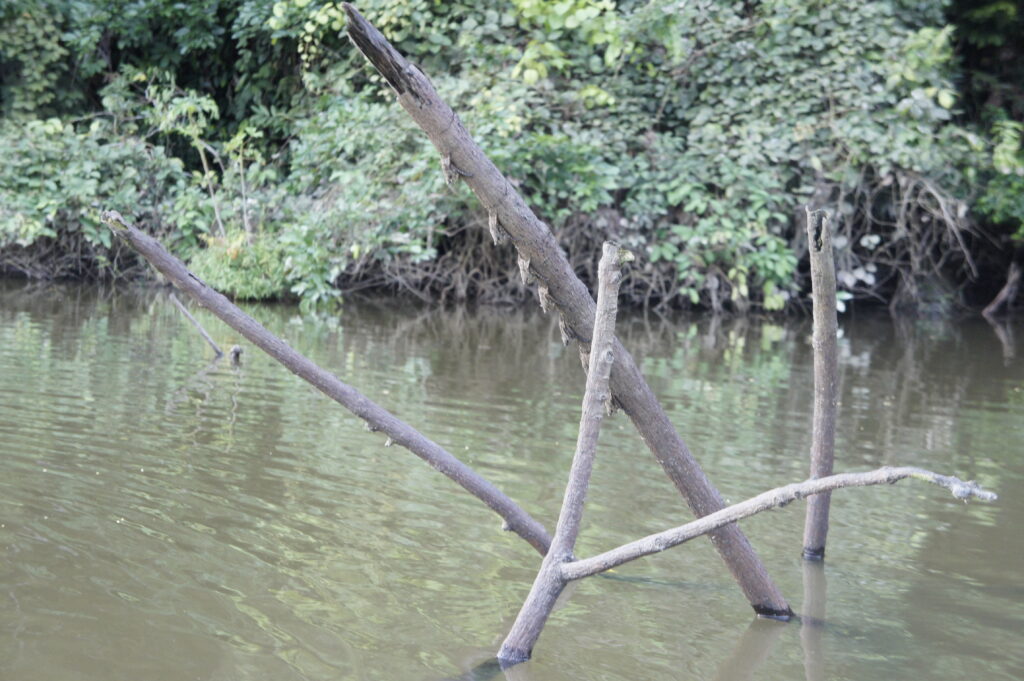
Can you spot the bats? Hint… check the underside of the log
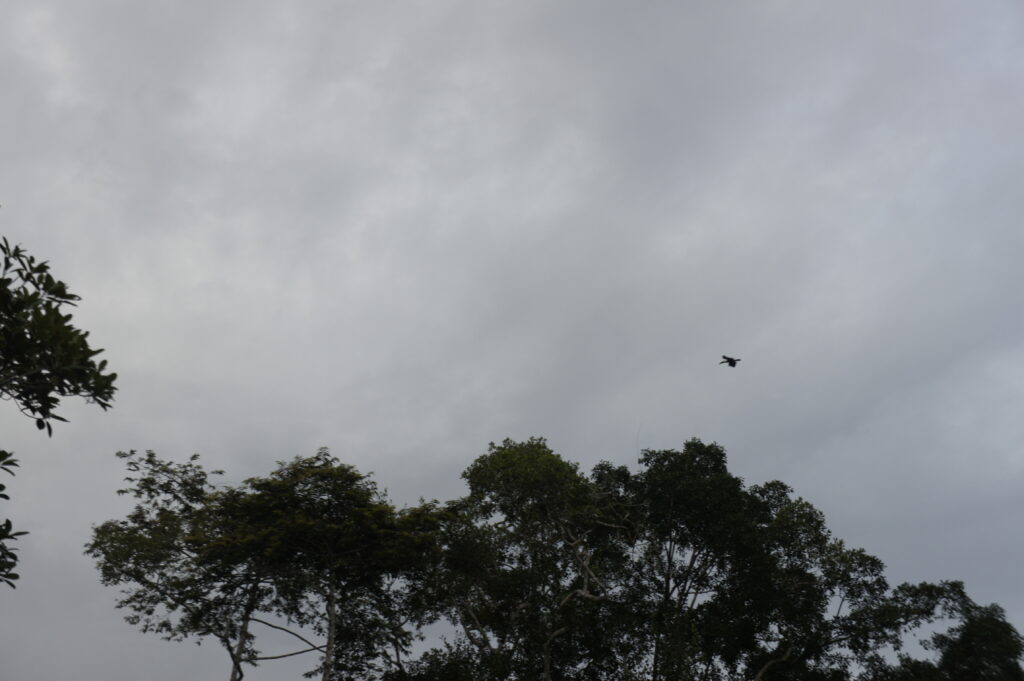
A toucan flies overhead
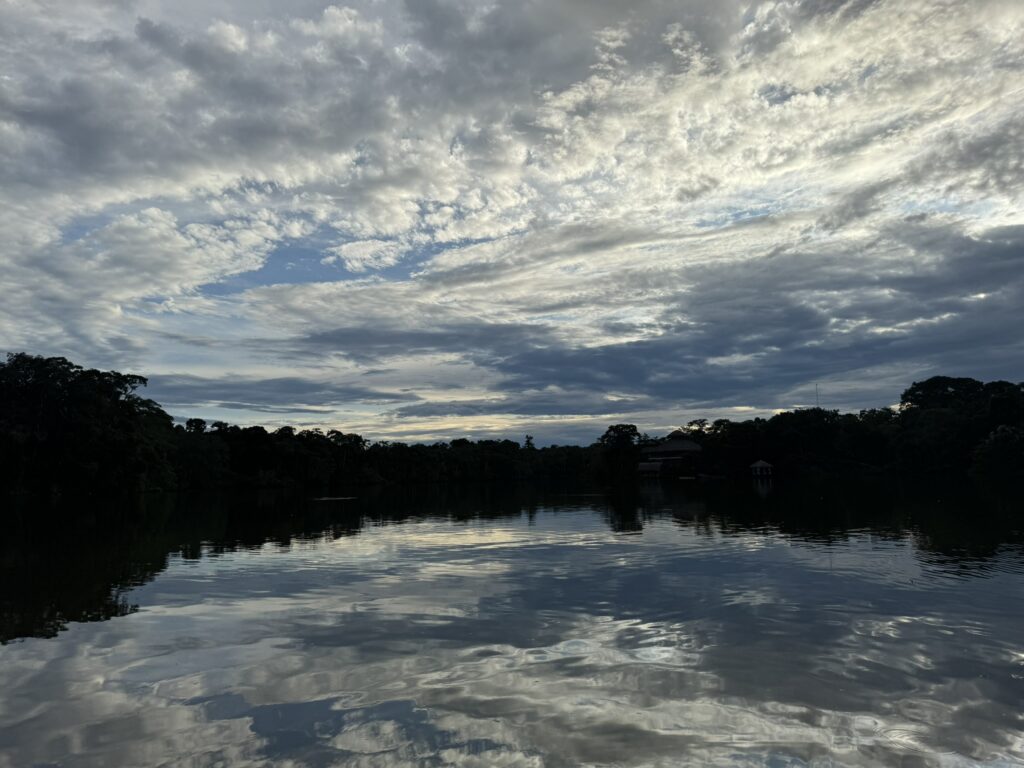
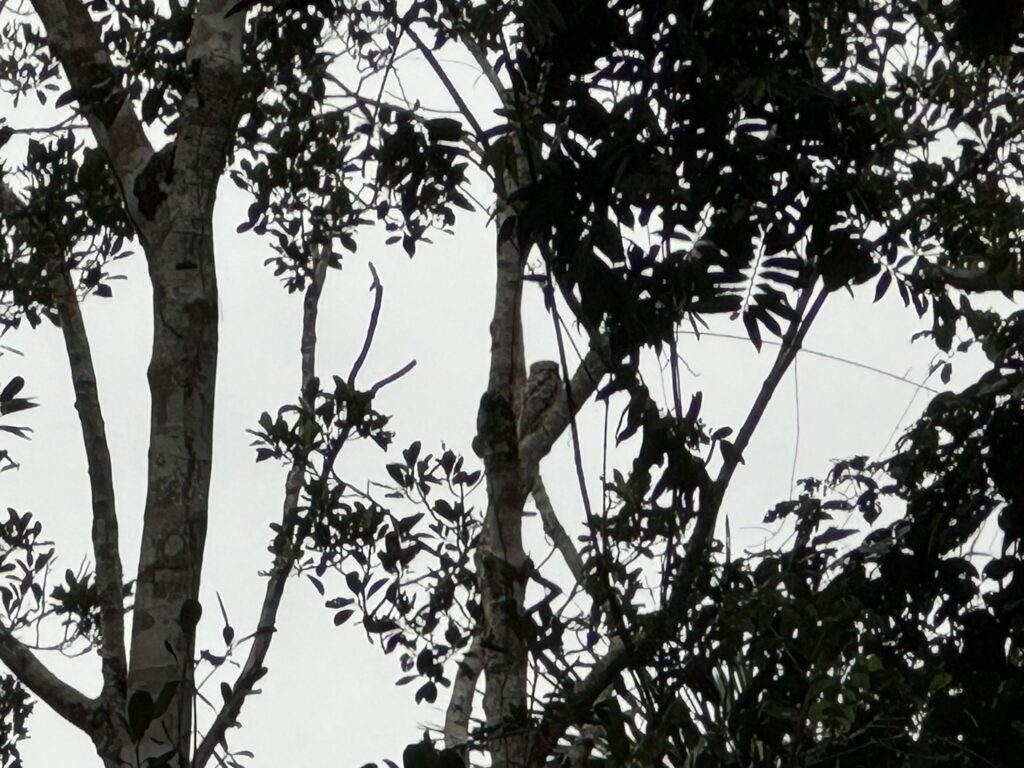
Can you spot the bird in the crook of the tree? I believe this one is a caracara
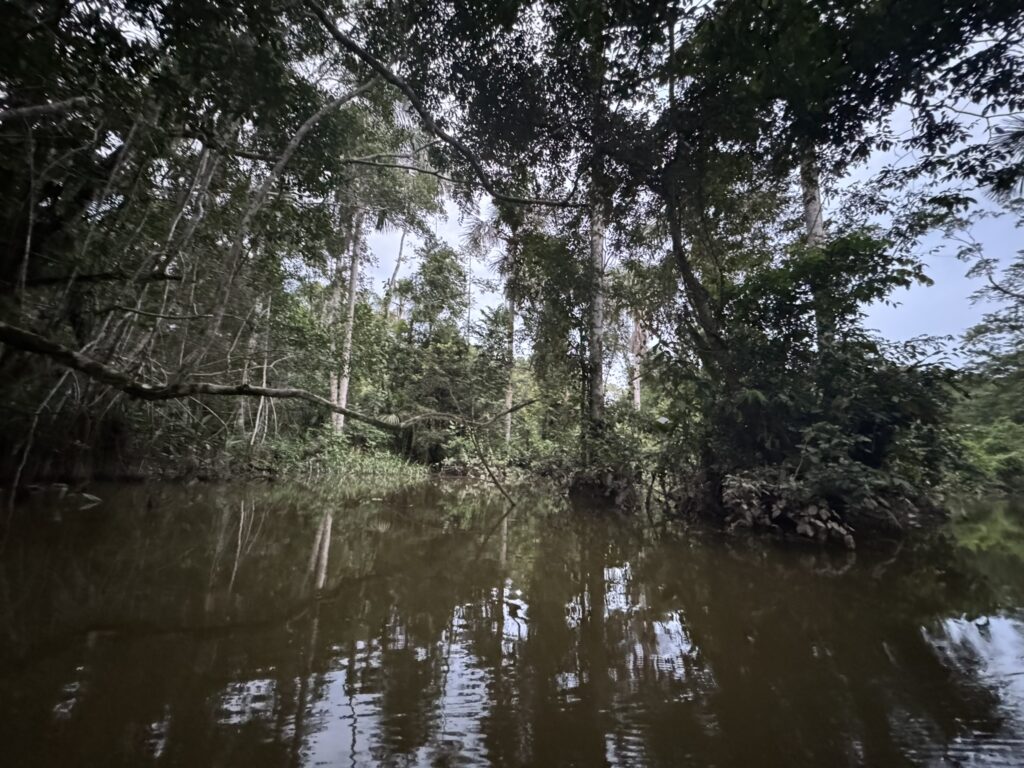
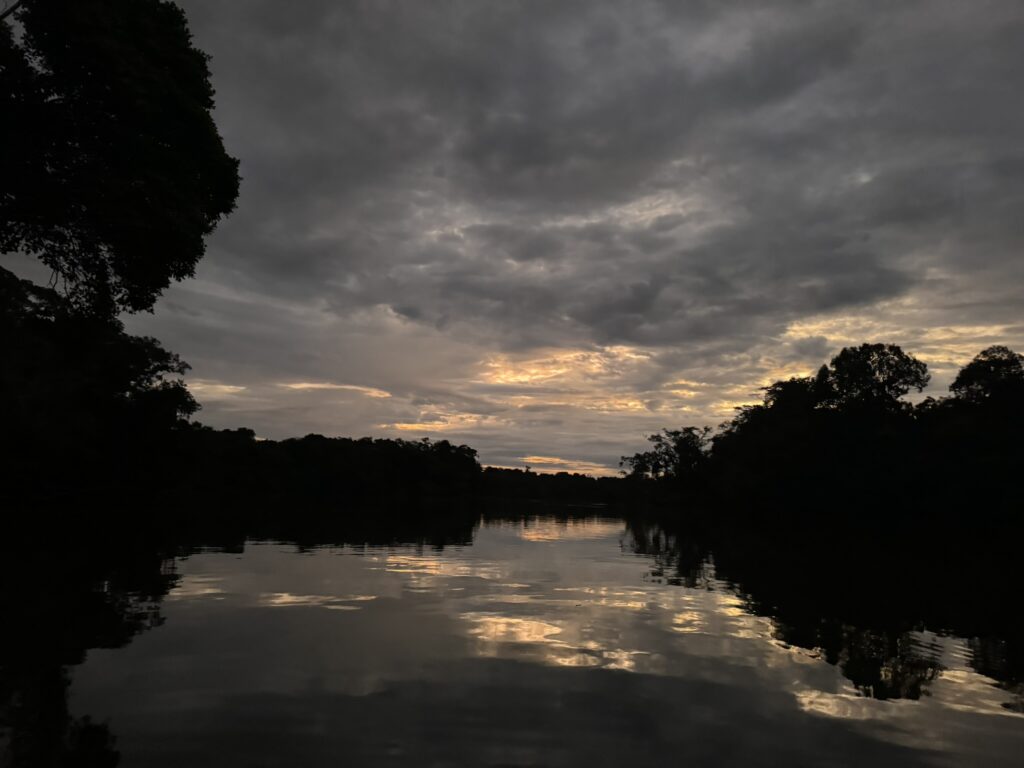
We also got up-close-and-personal with a black caiman, the largest of the sub-species:
Despite its size, it’s still very much wary of humans and dove soon after we approached. But there have been occasional reports of aggressive behaviour during nesting season, which is why guests can no longer go swimming off the dock. (Personally I’d ruled that out the moment I heard the word ‘piranha’ – but maybe that’s just me.)
Back to the resort 40 minutes before dinner – my wife and daughter opted to have a shower before the meal, but we still managed to make it with time to spare.
Another delicious meal, including Ecuadorian swordfish:
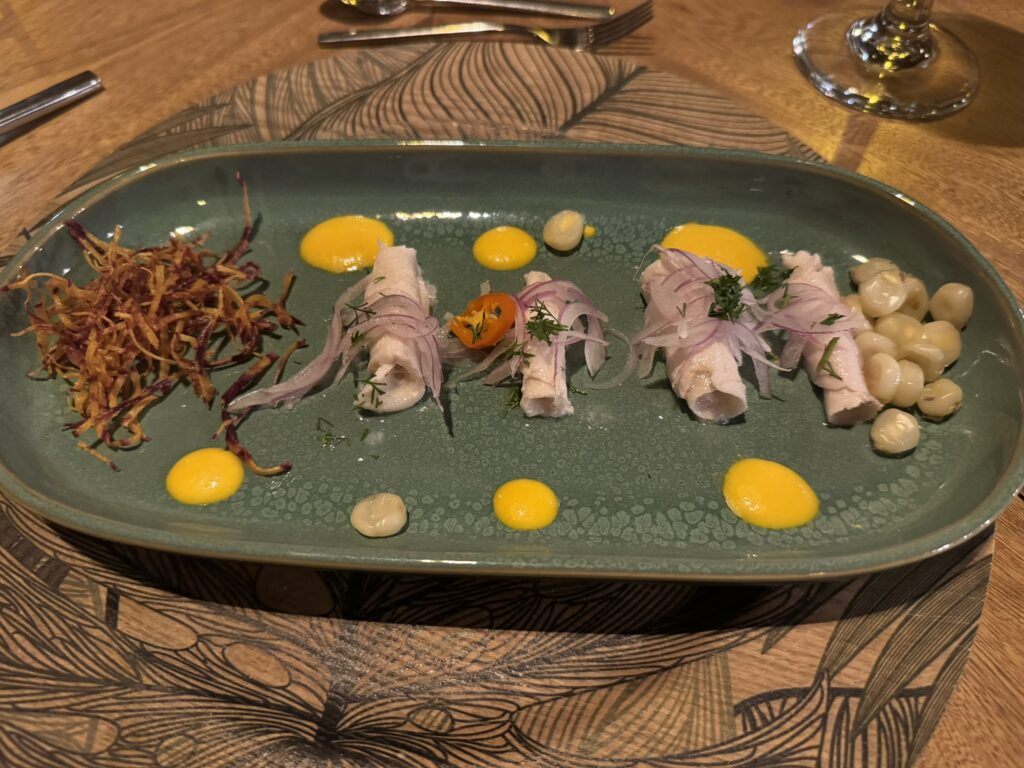
And panko-crusted chicken with thyme:
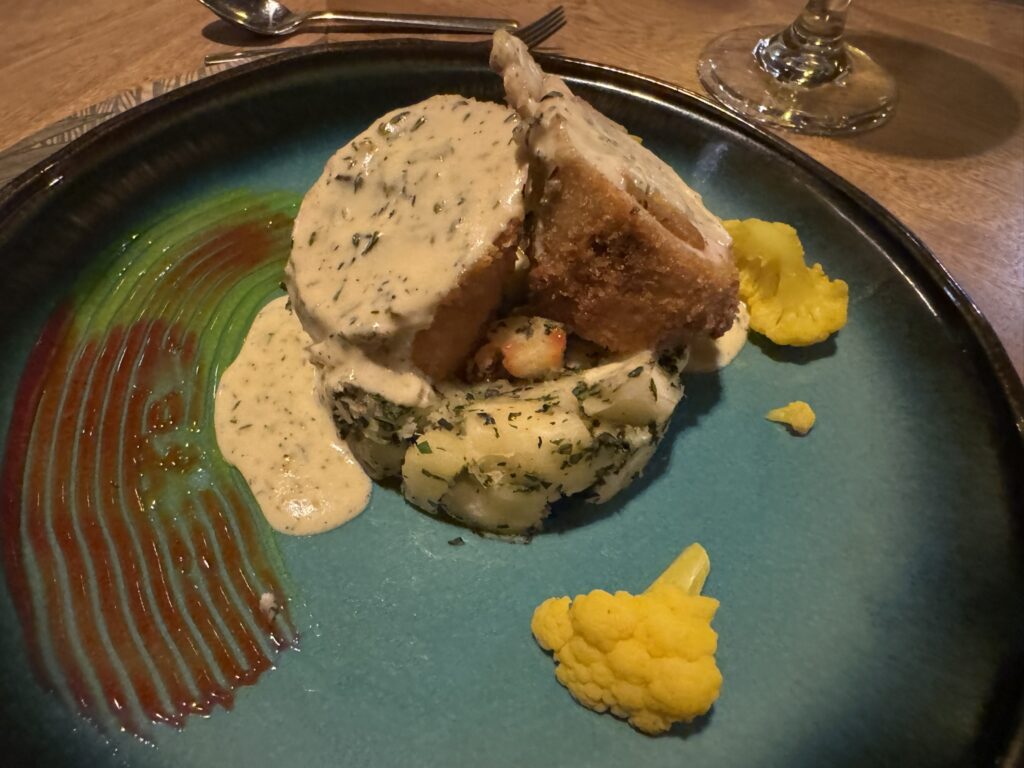
Finished off with a trio of desserts, including a coconut cake:
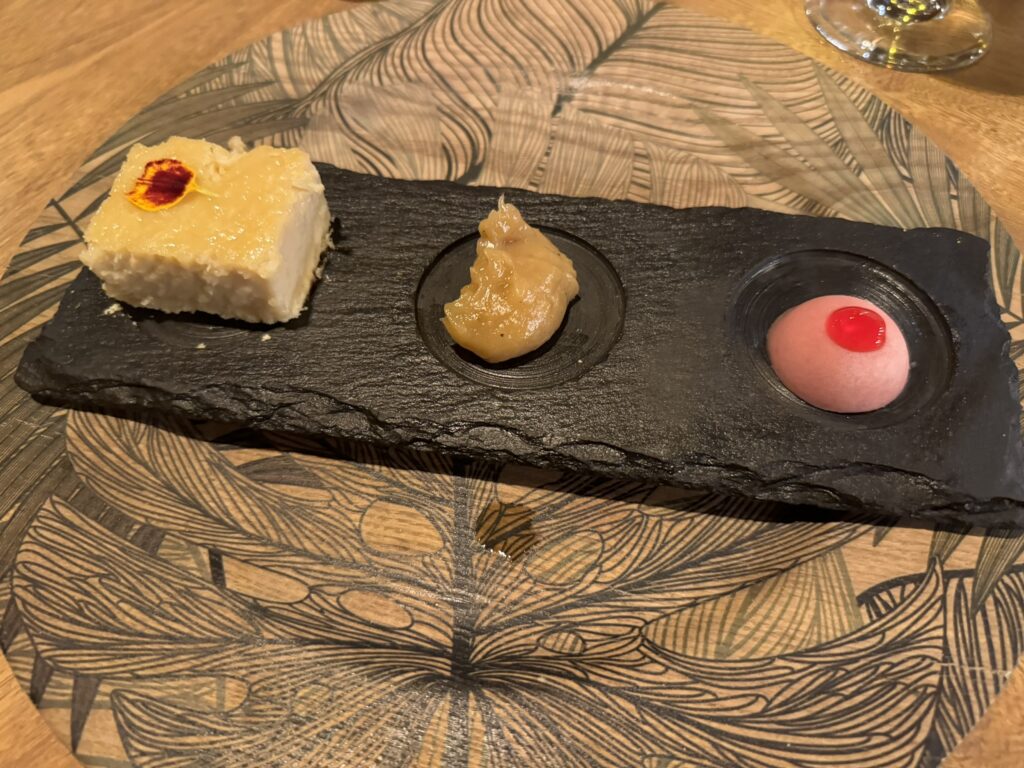
At this point, the day had long since caught up with us. It was time to say our goodbyes to the lovely couple that had joined us for the first few days of our trip – and who were heading back to Quito early the next morning – and to prepare ourselves for the day ahead.
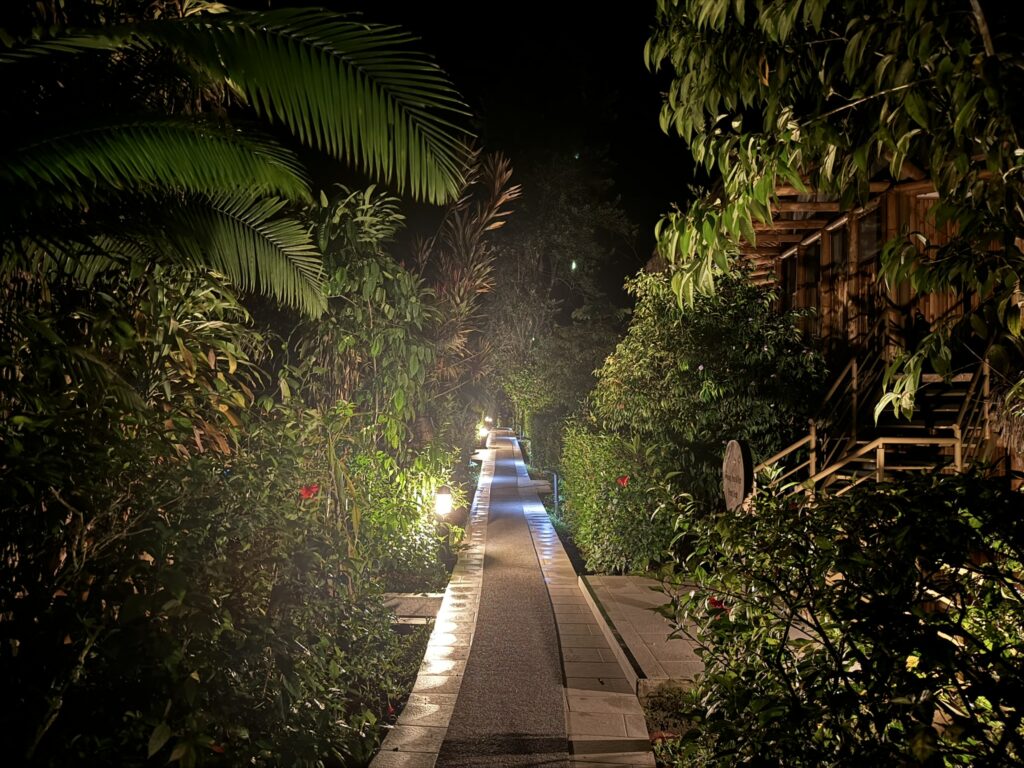
Continue reading Ecuador and the Galapagos – Day 6.
